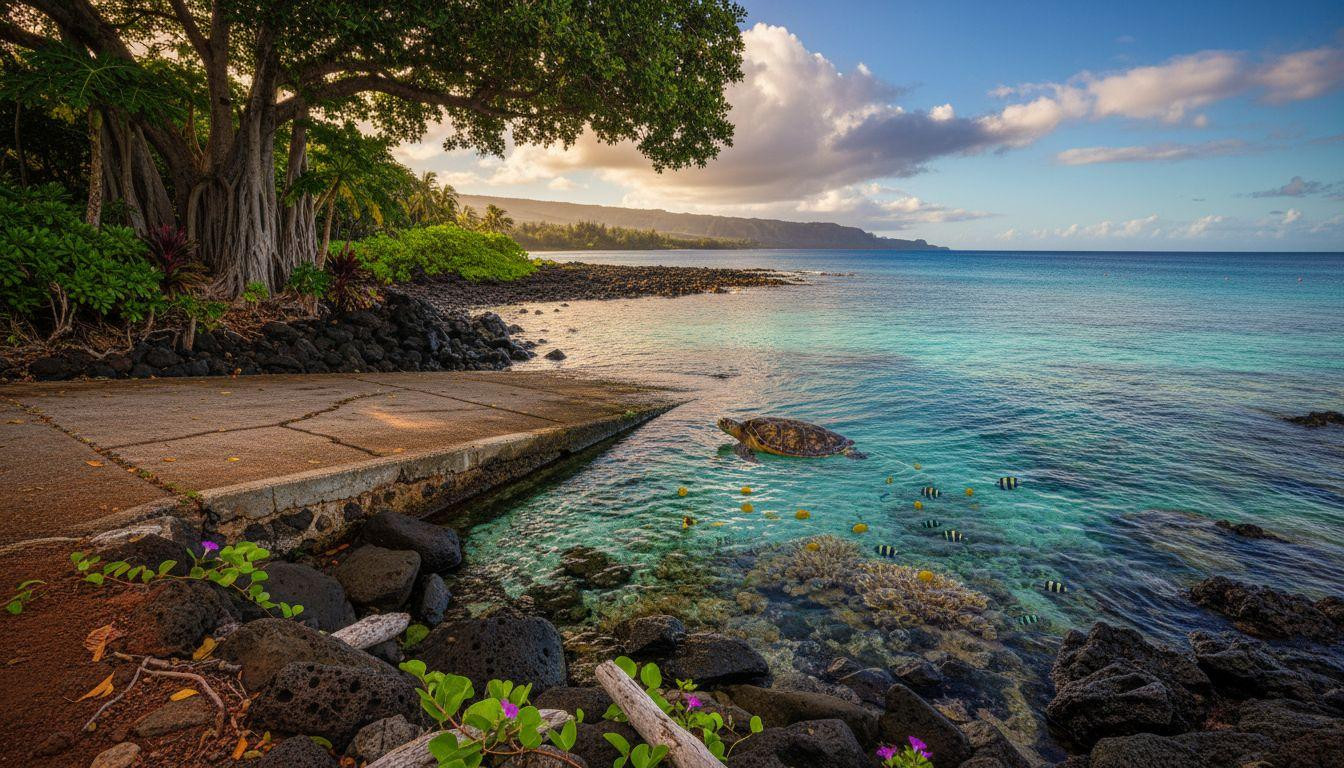The 7:30 AM shuttle bus from Lahaina drops off cruise passengers at Kaanapali Beach where $10 parking spots fill before 9 AM and guided snorkel tours cost $175 per person. Four miles north, Honolua Bay’s free roadside parking accommodates 15 cars maximum, filtering crowds naturally through a forest trail that leads to Maui’s most pristine marine reserve.
Forget Lahaina’s commercialized resort beaches
Kaanapali Beach stretches 3 miles along Maui’s western shore with resort towers casting shadows across imported sand. Non-residents pay $10 minimum for parking while Hawaii residents park free with valid ID. The Whaler’s Village parking structure charges premium rates that can reach $65 daily during peak season.
Wailea Beach offers free public parking but resort guests monopolize prime beach access points. Snorkeling tours departing from Lahaina harbor promise turtle encounters for $175-200 per person including gear rental. Morning departure times sell out weeks in advance during summer months.
These beaches serve 3 million annual Maui visitors who concentrate at developed shorelines. Concrete walkways, beach chair rentals, and poolside service create artificial Hawaiian experiences. The authentic marine encounters happen elsewhere.
Honolua Bay’s Marine Life Conservation District protects what matters
Established in 1983, the Honolua-Mokuleia Marine Life Conservation District encompasses coral reefs that thrive without commercial boat traffic. Summer months (May-September) bring glass-calm conditions with 60-100 feet underwater visibility. Green sea turtles glide through coral canyons while yellow tangs and Moorish idols school in protected waters.
The forest trail that filters tourists
Highway turnouts accommodate maximum 15-20 vehicles along Honoapiilani Highway near mile marker 32. A well-marked dirt path descends through papaya trees and banyan forest canopy to volcanic rock shoreline. The 0.2-mile trail drops 100 feet in elevation, requiring 10-15 minutes walking time each direction.
Limited parking creates natural crowd control impossible at resort beaches. As one recent visitor noted: “Parking is catch as catch can but spaces become available as others leave.” This constraint preserves the bay’s pristine character.
Rocky coastline versus imported sand
Honolua Bay’s volcanic shoreline creates diverse reef habitats supporting endemic Hawaiian fish species. Unlike resort lagoons with artificial beach access, this rocky coast rewards snorkelers with authentic marine encounters. Coral formations extend from 5-40 feet depth with natural swim-through channels.
The snorkeling experience resort beaches cannot replicate
November 2025 marks the transition from summer calm to winter surf season. Morning hours (6-9 AM) offer the clearest water before afternoon trade winds arrive. Reef-safe sunscreen requirements protect coral health while fishing restrictions maintain fish populations.
Marine life encounters without guided tours
Hawaiian green sea turtles (honu) feed on algae growing on volcanic rocks throughout the bay. Moorish idols, yellow tangs, and trumpetfish populate coral gardens visible from the surface. Hawksbill turtles, rarer than their green cousins, occasionally appear in deeper sections.
Summer water temperatures reach 78-82°F while November averages 76°F. The Marine Life Conservation District designation since 1983 has allowed coral recovery impossible near resort developments. Pristine coral formations rival tropical destinations costing thousands more.
Hawaiian cultural respect in practice
Native Hawaiian concept of malama ‘aina (caring for the land) guides conservation efforts at Honolua Bay. Portable restrooms maintain sanitation while prohibiting permanent structures preserves natural character. Winter months bring professional surfers for competitions but summer belongs to snorkelers and turtles.
Why locals protect Honolua Bay’s low-key status
Maui County’s 170,000 residents understand that limited access preserves what unlimited development destroys. Free access to world-class snorkeling represents authentic Hawaii that commercialized beaches have lost.
The 10-minute drive from Lahaina town center connects visitors to protected marine ecosystems without resort fees or tour operator schedules. Early morning arrival ensures parking availability and optimal water conditions before crowds arrive.
Local residents frequent Honolua Bay precisely because tourist infrastructure remains minimal. Natural access restrictions preserve experiences that unlimited development would destroy.
Your questions about Honolua Bay answered
What time should I arrive for the best experience?
Parking fills by 9 AM during peak season (June-August) and holiday periods. Arriving before 8 AM guarantees parking while providing optimal snorkeling conditions before afternoon winds. Water clarity peaks during morning hours when sediment settles overnight.
How does Honolua Bay compare to resort beach snorkeling?
Resort beaches serve convenience while Honolua Bay rewards effort with authentic marine encounters. The Marine Life Conservation District protection since 1983 maintains coral health and fish populations impossible near resort developments. Free access eliminates $175 tour costs while providing superior underwater experiences.
What facilities are available at the bay?
Portable restrooms serve visitors while preserving natural character through minimal infrastructure. No showers, shade structures, or food services maintain the site’s protected status. Snorkel gear rental in Lahaina costs $15-25 daily compared to resort equipment included in expensive tour packages.
Morning light filters through forest canopy as hikers descend toward turquoise water meeting volcanic rock. Hawaiian green sea turtles surface between coral formations while yellow tangs dart through crystal-clear shallows. The forest trail approach preserves what four decades of protection have created: Maui’s most authentic marine sanctuary.
